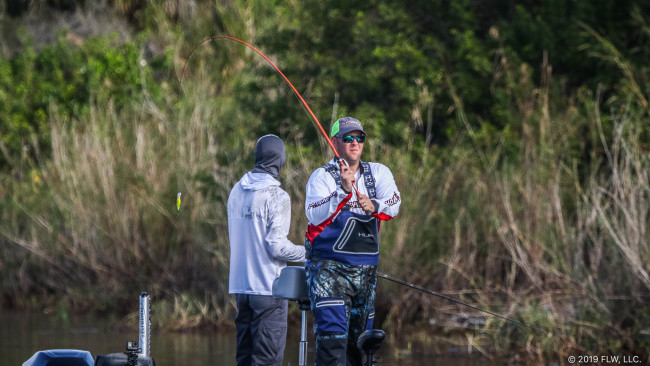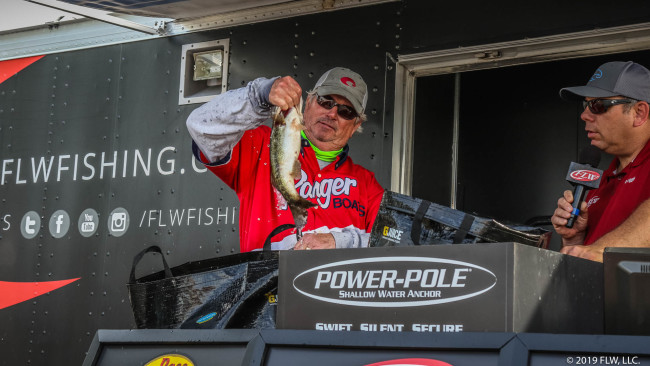Top 10 Patterns from Okeechobee
Canals were vital for getting winning bites on the Big O

Nick Thliveros grabbed his first win from the front of the boat by taking advantage of stable conditions the numerous canals around Lake Okeechobee have to offer. The lake wasn’t fishing like it usually does this time of year, and several pros in the top 10 followed Thliveros’ lead, choosing to target canals rather than search the dirty, cooler water found in the lake.
Whether it was a canal or small sections of the lake, each pro in the top chose to hunker down in an area and milk it for all it was worth in the season opener of the Costa FLW Series Southeastern Division presented by Power-Pole. Here’s a look at how the action unfolded.

2. Nichols stays near the main lake
Cody Nichols of Fayette, Ala., has only been to Okeechobee one other time before this event, so he didn’t have any preconceived notions. While most of his practice was slow, the final 30 minutes on his third day proved vital.
“I was fishing in South Bay in a big lily pad area,” says Nichols. “I actually found the spot in the last 30 minutes before dark, and I think they were just starting to move in there. I was probably 200 yards from the outside grass line, so it was a place that the fish were moving up to for spawning.”
With a north wind on day one, Nichols’ spot sported a little dirty water, leaving him to catch 12 pounds, 10 ounces. It cleaned up on day two and he cracked 17-6 to put him in the top five. On the final day, Nichols scratched another 12 pounds from there, but if the tournament would have been a day longer, who knows what could have happened? The fish were really starting to push shallow at that point.
Nichols caught the majority of his fish on a 3/8-ounce white homemade swim jig paired with a NetBait Paca Craw. He also mixed in a Reaction Innovations Skinny Dipper and a 7-inch Trickster Stick Worm.

3. Abram hunkers down in J&S
Jason Abram had the same idea as Thliveros when it came to focusing on a canal. In fact, they shared water the entire event. The Piney Flats, Tenn., pro tried hard to rally on the final day with the biggest bag of the final round (weighing 17-4) with the help of an 8-pounder he caught early in the day. While it wasn’t enough for the W, he walks away with a good amount of points and a solid payday.
Abram honed in on two different 1/2-mile stretches in the J&S canal where he had to just make as many casts as he could until the fish turned on.
“The fish in the canal were staging on a ledge in 3 to 5 feet where it dropped to 16 off the edge,” says Abram. “You’d catch one every now and then and then go a while without a bite. It was like when they’d move up out of deep water they were ready to eat.
“The biggest key was finding the deepest water to the 3- to 5-foot ledge. I’d throw the crankbait along the rock and when there’d be a stickup or reeds, I’d flip them.”
His crankbait was an Uncle Ernie flat-sided crankbait and when he came across cover to flip, a soon-to-be-released Reaction Innovations’ bait called a Spicy Beaver on a 5/16-ounce weight got the call.

4. Preuett stays close
Shallow, muddy water isn’t exactly picture-perfect water on Okeechobee, but it didn’t deter Monroe, La., pro Brett Preuett. The former YETI FLW College Fishing National Champion went off a bit of experience and few bites he found in practice to net his first FLW Series top 10.
Unlike the rest of the top pros, Preuett had a large area near the East Wall all to himself. He didn’t fish it until later in the day on day one and scrounged up 8-8 with just four bass. On day two, he camped in there all day and sacked up 18-14 to make one of the biggest leaps of the event.
“On day three of the [FLW] Tour event last year I culled twice in that area and lost a 5-pounder,” Preuett says. “It’s an area I’ve been to in the past, and I got three bites in practice from there. Other than the first day, I’d never crank my big motor once. I shut down until it was time to head to weigh-in.”
Preuett’s fish were moving shallow looking to spawn. If not for some lost fish throughout the event, he could have threatened Thliveros for the title.
“I was fishing shallow in the mud,” Preuett adds. “Shallow enough that with my trolling motor all the way up I was still kicking up mud. I was catching females moving in next to single bushes, but I also lost some, too. I wish I had one more hour to fish [on the final day] because it was getting good.”
Preuett used three different weapons to cover the vast expanse of shallow reeds, pads and bushes: A 3/8-ounce Treeshaker Shaker Blade matched with a 3 1/2-inch Creme Reel Scremer swimbait or a 5-inch Reel Scremer covered water, while a homemade prop bait came in to make precise casts next to likely areas fish would spawn.
5. Melvin cranks a canal
Veteran FLW angler Sandy Melvin of Boca Grande, Fla., was fresh off the top 10 in the T-H Marine FLW Bass Fishing League (BFL) event the week prior, and momentum carried over to this event.
Melvin implemented a one-two punch of starting in Uncle Joe’s Cut to get a limit before heading out to a spawning area in the lake to check for fish pushing shallow with slowly warming water.
“The cold water in the lake had the fish not wanting to bite,” Melvin says. “That’s why I started in the canal, because I knew I could get bit. I also knew that at any moment the lake could turn on, which I why I would go check it after I got a limit. I figured the canal could get me to day three, which is what I wanted, but the wave never pulled up. I caught 40 fish on the final day, but no females. If we had one more day it would have been good.”
Melvin didn’t get wild with baits and needed just a Lucky Craft LC 1.5 square-bill and a Texas-rigged Bitter’s Skip Shad in watermelonseed to trick fickle Okeechobee bass.

6. New slows down in South Bay
Bryan New picked up right where he left off after a top-10 finish at the Costa FLW Series Championship last November.
“I was fishing in South Bay where I got two bites in practice,” says the Belmont, N.C., pro. “It was the best-looking thing I had, and I’ve caught them in there before.
“I started fishing the eel grass out in the open, but after a while, I moved to the reed clumps and caught a good one flipping. From then on I did that for the rest of the tournament.”
A Texas-rigged, weightless Damiki Stinger pitched on a 7-foot, heavy-action Fitzgerald Stunner HD rod with 20-pound-test P-Line fluorocarbon was his main choice to shallow reeds. Later in the day, once the sun came out, he flipped a Damiki Air Craw on a 5/16-ounce weight to the heart of the clumps on a 7-foot, 3-inch, heavy-action Fitzgerald Stunner HD rod with 50-pound-test P-Line braid. With warmer water on the final day, he pulled out a Greenfish Tackle TAT – which he threw on the same rod as the Stinger – but with 17-pound-test P-Line monofilament.
7. Oligschlaeger is a one-rod wonder
Lance Oligschlaeger stuck to the Harney Pond canal after catching an 11-pounder there in practice – and who would blame him?
He weighed in 14-6 on day one with just four bass – all of which he caught in the final hour of fishing after spending the earlier part of his day on what he thought would be a “limit spot.” On day two, he committed to the same area and caught 16-4. The magic ran out on the final day, but it was still a solid event for the Gallatin, Tenn., pro.
“There were a lot of places in the canal that looked good, but I’d look at my Lowrance for places where the contour lines got tighter together,” says Oligschlaeger. “The tight contours are where there was a harder bottom. Most of the bottom in the canal had a bunch of slim on it, but those hard areas were pretty clean.
“There was also a lot of bait around the hard bottom places. For the big bites, you needed to be around the bait.”
Oligschlaeger went old-school in his cranking approach, opting for a Rapala Risto Rap, which are now discontinued. The one he used also happened to be the only one he had with him, so when the bill broke off the body in practice, things looked grim. Fortunately, he super-glued the bill back on and it made it through the entire event.
8. Parsons keeps it simple
David Parsons hasn’t had the best relationship with Okeechobee through the years, but a small 100-yard patch of hydrilla and lily pads in South Bay cured that.
“The Sunday before the tournament I went out and killed them in that spot,” Parsons says. “I had probably 20 bites, but the rest of practice was terrible. I just went back to it, Power-Poled down and stayed there all day.”
Despite having at least 20 boats around him the first two days, he still caught limits worth 12-8 and 13-15 to establish himself as one of the more consistent anglers in the top 10.
In true Okeechobee fashion, Parsons threw a Gambler Big EZ or a Yamamoto Senko with a 1/8-ounce weight.
9. Google Earth leads Hall to honey hole
Billy Hall of Greenback, Tenn., did his homework to find a hidden gem all to himself.
“I fished in Pelican Bay and actually found the spot looking at Google Earth,” says Hall. “It looked like an airboat trail or something, and when I got in there, I found really clear water and a 200-yard stretch of reeds with pockets in them.
“I had to make long-distance casts because the water was so clear, but it was a place where I knew fish would be moving in, and it kind of acted like a funnel or a front door to where they’d spawn.”
According to Hall, fluorocarbon was a must. His main setup was 20-pound-test Seaguar Tatsu on a 13 Fishing Concept Z reel with a Cashion rod. On the business end, a Texas-rigged Bruiser Baits Stick Worm with a 1/16-ounce weight is a tried-and-true approach, but the twist was that he added a small screw-in willow blade on the back, and it made all the difference. He also covered water with a Missile Baits Shockwave.
10. Osinski sticks to Clewiston
No stranger to top 10s on the Big O, Val Osinski padded his resume some more, though it wasn’t in a way he’s used to.
“This was an unusual tournament,” Osinski says. “I spent three days in one area; I never do that. I found an area close to takeoff where I felt confident and just hunkered down and fished. I flipped the thicker grass when it was cooler and fished the spare cover when it warmed up. I think it was important that the area had easy access to the main lake, making it easy for fish to come in to spawn.”
When he flipped Kissimmee grass mats, Osinski reached for a Gambler Ugly Otter, which he matched with a Starflash punch skirt. In the thinner stuff, he threw the brand new Gambler EZ Vibez swimbait or ol’ faithful – a Fat Ace.




